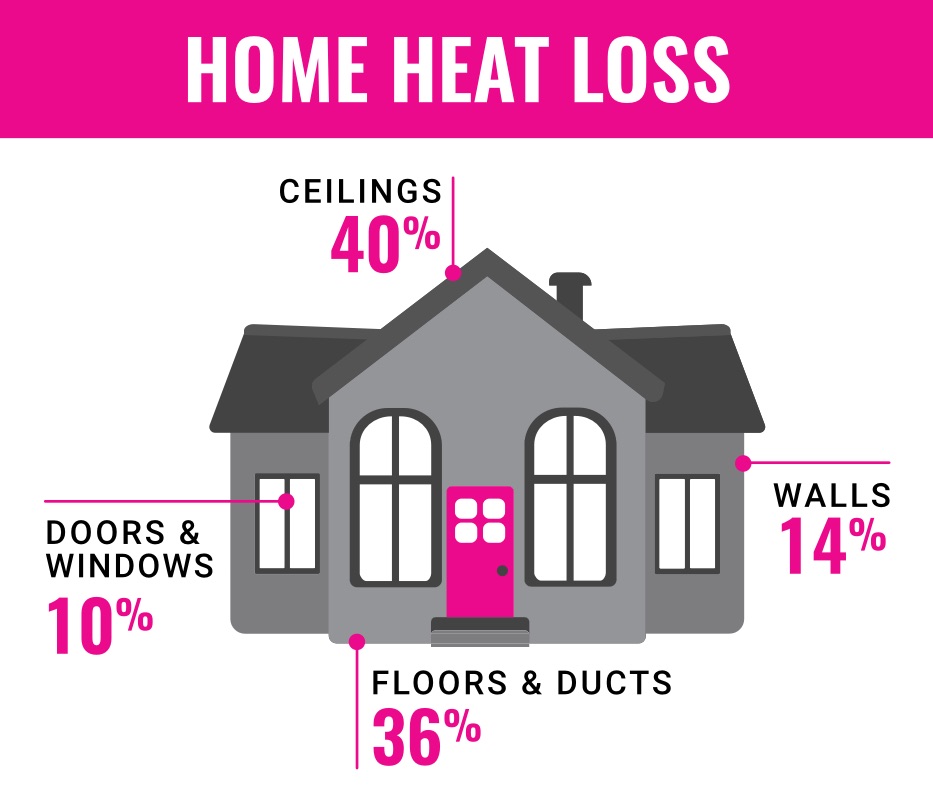
Why Insulate? — An Introduction to Insulation
Although insulation is an important element of building, it is often the least understood. Many people aren’t aware of the multiple places energy is lost in a home.
Insulation lays a foundation of energy efficiency for residential, commercial and industrial structures. It is one of the most cost-effective ways to save energy and reduce monthly energy bills. Whether you are remodeling a home or building a new business, well-installed insulation offers a host of short-term and long-term advantages:
- Increased, more consistent interior comfort all year long
- Reduced energy usage
- Lower heating and cooling costs
- Less wear and tear on HVAC equipment
- Reduced noise transmission for a quieter space
- Improved air quality
- Reduced moisture intrusion
- Less overall environmental impact
How Insulation Works
Heat flows from higher temperature areas to lower temperature areas, creating temperature fluctuation within a space. Insulation wraps your home or building in a protective blanket, reducing heat flow in order to keep the heat out during warmer months and the heat in during cooler months. Insulation is an excellent noise absorber and helps to reduce sound transmission from both outside and within a home, creating a quieter space with less reverberation. Insulation also allows other energy-efficient components, such as air sealing, to do their job, forming a comprehensive insulating system that helps maintain consistent temperatures and moisture levels, reduce energy usage and increase monthly utility savings.
What Is R-Value?
The “R” in R-value stands for resistance to heat flow. The higher the R-value, the higher the level of resistance and the greater the insulating power. R-value requirements vary depending on climate and building type.

Where to Insulate
Insulation should be installed in walls, floors, attic space, basement and crawlspace. A more detailed list includes:
- Ceilings with unheated spaces above, including dormer ceilings
- Knee walls of attic spaces finished as living areas
- Sloped walls and ceilings of attics finished as living areas
- Cathedral or vaulted ceilings
- Around perimeters of slabs
- Floors above vented crawl spaces
- Floors over unheated or open spaces such as over garages or porches
- Basement walls
- Band and header joists
- Interior walls, ceilings or floors where extra sound control is desired
- Floors over unconditioned basements
Things to Consider When Insulating
- What type of insulation is being used?
- Does the insulation meet or exceed local building codes and national recommended insulation levels?
- How effective is the insulation (thermal performance, acoustical performance)?
- Is the insulation resistant moisture, fire and settling?
- Is the insulation material safe and sustainable?
- Is the insulation cost effective?
Redline Insulation is well versed on the best types of insulation and applications to solve a variety of home comfort or energy loss issues and can recommend the best solution for your project.
Home Energy Auditing
An energy audit is an in-depth assessment of your building envelope conducted by a certified energy rater. According to RESNET, the authority on home energy auditing, home energy audits have three main objectives:
- Figuring out where and how energy is being lost
- Locating inefficient operating systems
- Determining cost-effective ways to enhance home efficiency and comfort
Your House as a System
Though insulation is one of the most essential and cost-effective ways to create overall efficiency, there are many factors to take into consideration that also affect your home’s energy efficiency and performance. Insulation and air sealing combined with energy-efficient appliances, windows, doors, lighting and HVAC equipment build a whole-house efficiency system that will prove beneficial throughout the year and for years to come.